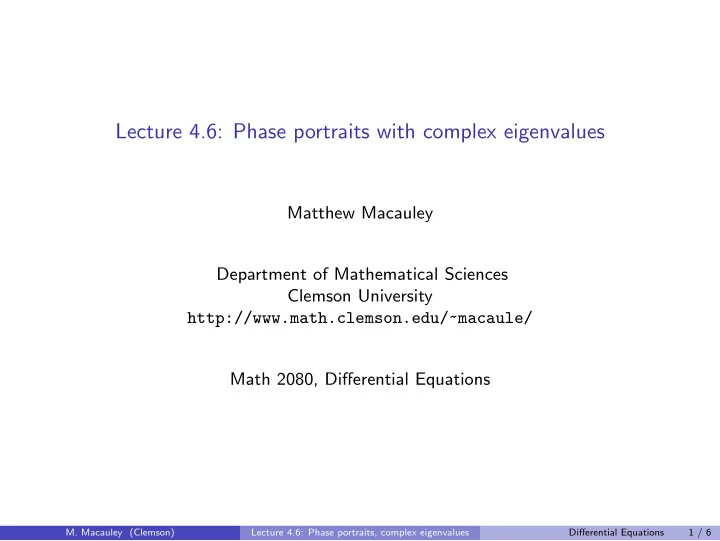

Lecture 4.6: Phase portraits with complex eigenvalues Matthew Macauley Department of Mathematical Sciences Clemson University http://www.math.clemson.edu/~macaule/ Math 2080, Differential Equations M. Macauley (Clemson) Lecture 4.6: Phase portraits, complex eigenvalues Differential Equations 1 / 6
Complex-valued solutions Lemma Suppose x 1 ( t ) = u ( t ) + i w ( t ) solves x ′ = Ax . Then so do u ( t ) and w ( t ). M. Macauley (Clemson) Lecture 4.6: Phase portraits, complex eigenvalues Differential Equations 2 / 6
Re-writing the general solution Example 2a � − 1 � x ′ � 1 � � x 1 � 1 Consider the following homogeneous system = 2 . − 1 x ′ − 1 x 2 2 2 It is easily verified that the eigenvalues and eigenvectors of A are � 1 � 1 � � λ 1 = − 1 λ 2 = − 1 2 + i , v 1 = ; 2 − i , v 2 = . i − i � 1 � 1 � � Thus, the general solution is x ( t ) = C 1 e ( − 1 + C 2 e ( − 1 2 + i ) t 2 − i ) t . i − i M. Macauley (Clemson) Lecture 4.6: Phase portraits, complex eigenvalues Differential Equations 3 / 6
Phase portraits Example 2a (cont.) � cos t � � sin t � Let’s plot the general solution x ( t ) = C 1 e − t / 2 + C 2 e − t / 2 . − sin t cos t M. Macauley (Clemson) Lecture 4.6: Phase portraits, complex eigenvalues Differential Equations 4 / 6
Purely imaginary eigenvalues Example 2a � 1 − 5 � x ′ � � � x 1 � � − 1 � 1 Consider the following initial value problem = 2 4 , x (0) = . − 1 x ′ 2 − 2 x 2 2 2 It is easily verified that the eigenvalues and eigenvectors of A are � � � � λ 1 = 3 5 λ 2 = − 3 5 2 i , v 1 = ; 2 i , v 2 = . 2 − 6 i 2 + 6 i � � � � 5 5 3 + C 2 e − 3 2 it 2 it Thus, the general solution is x ( t ) = C 1 e . 2 − 6 i 2 + 6 i M. Macauley (Clemson) Lecture 4.6: Phase portraits, complex eigenvalues Differential Equations 5 / 6
Concluding remarks Summary Suppose we wish to solve x ′ = Ax , where λ 1 , 2 = a ± bi , b � = 0. We have two solutions: x 1 ( t ) = e ( a + bi ) t v 1 and x 2 ( t ) = e ( a − bi ) t v 2 . Take one of these (say x 1 ( t )), and use Euler’s formula to write it as x 1 ( t ) = u ( t ) + i w ( t ). The general solution is x ( t ) = C 1 u ( t ) + C 2 w ( t ). The phase portrait will have ellipses, that are spiraling inward if a < 0; spiraling outward if a > 0; stable if a = 0. M. Macauley (Clemson) Lecture 4.6: Phase portraits, complex eigenvalues Differential Equations 6 / 6
Recommend
More recommend